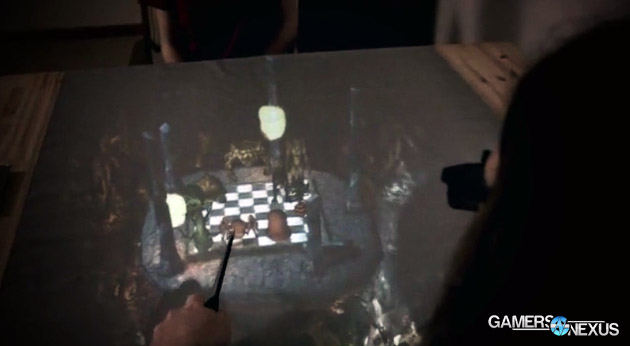The timing for this advancement in augmented reality is particularly convenient, given our content plan to publish a large virtual reality article in the next day or two. Ramping into this article, though, we'll talk briefly about Technical Illusions' castAR glasses.
 The castAR system uses light and holography to produce an interactive, real-world 3D projection.
The castAR system uses light and holography to produce an interactive, real-world 3D projection.
As opposed to the Oculus Rift, a virtual reality head-mounted display (HMD) that enhances gaming experiences by improving player immersion, castAR takes the augmented reality approach. Augmented & Virtual Reality are similar in their dedication to immersion and fidelity, but differentiate themselves in implementation; AR devices generally augment the real world (already used in psychiatry and psychology), while VR tends to stick with digitally-rendered environments.
Up until castAR, there wasn't a whole lot out there in terms of modern AR on the consumer-level. Technical Illusions' kickstarter video offers insight as to what the pair of glasses could be used for, showing two of its developers playing chess in "real life" without use of any physical pieces:
Using schools of discipline from holography, this particular rendition on AR uses small projectors hosted above each lens, which casts a stereoscopic 3D render onto a flat, viewable surface. Once this is cast, an infrared scanner locates pointers projected onto the surface, used for head tracking and orientation (making it so that if you turn your head, the illusion adjusts properly - otherwise the holography trick would be ruined).
Provided with the castAR glasses is a "retro-reflective sheeting material, similar to the kind used in traffic signs and high-visibility safety clothing," the castAR page explains. This sheet is spread over the surface, then used to interact with the head-mounted camera and projectors. Further still, the team has developed a "magic wand" peripheral, which serves as a 3D input device with six-axis awareness; the device is fitted with a tracker, standard button set, and an analog joystick. This can be used, as in the video, to interact with the projected environment. It can also be deployed for use with other systems.
If you're a tabletop RPG player like some of the GN staffers, the Kickstarter video demonstrates castAR being used to hand-build a 3D dungeon map atop the AR surface, which players can then interact with -- effectively a replacement for minis.
Augmented Reality overcomes most nausea and disorientation issues that some users experience with virtual reality, because it leaves the user perceptually aware of the "real" world.
The Kickstarter is still running, but the ex-Valve team members have reached their $400,000 goal and still have 29 days remaining. Backers who'd like the castAR starter package (including the glasses and surface) can jump in at $190, though other donations and products are available at lower prices.
- Steve "Lelldorianx" Burke.